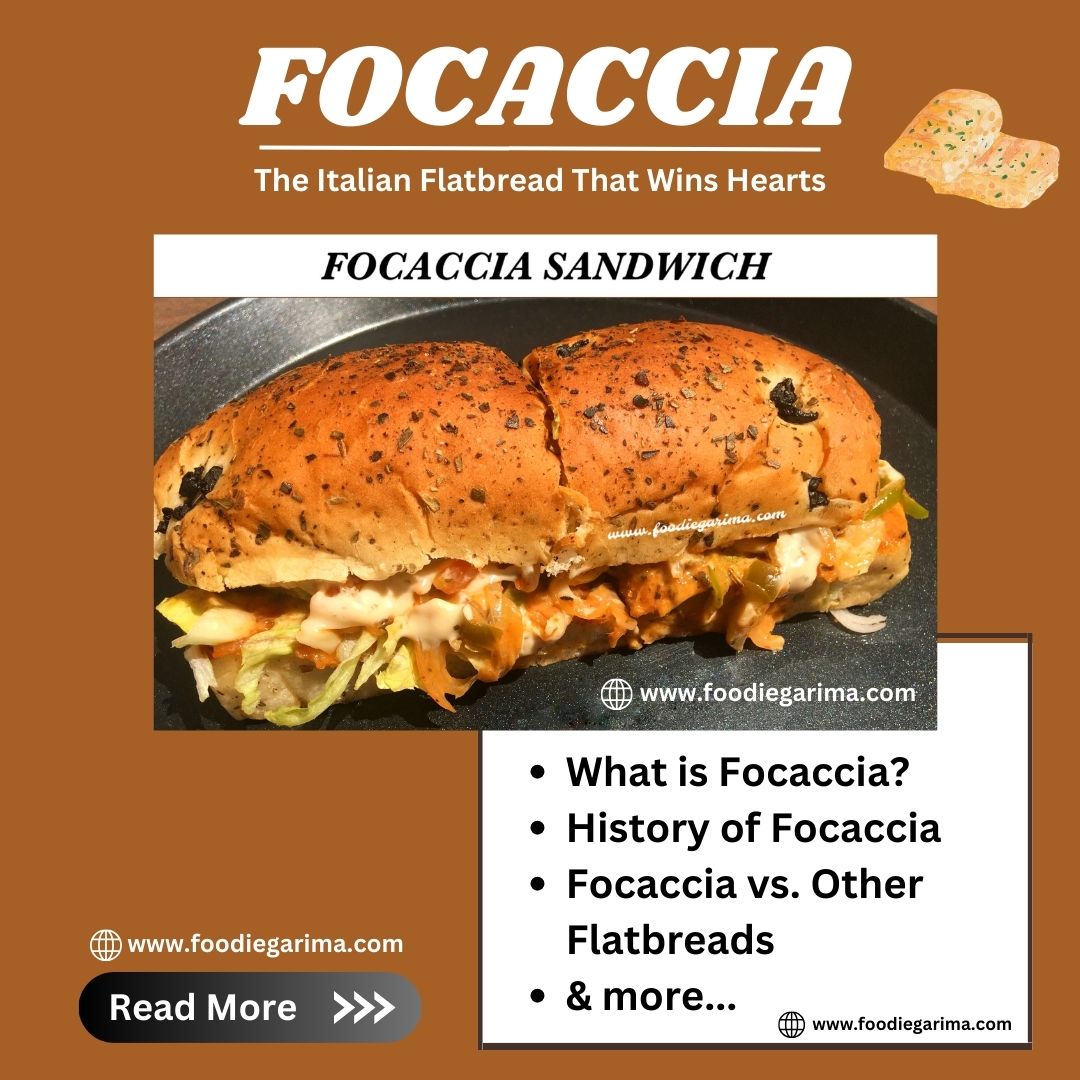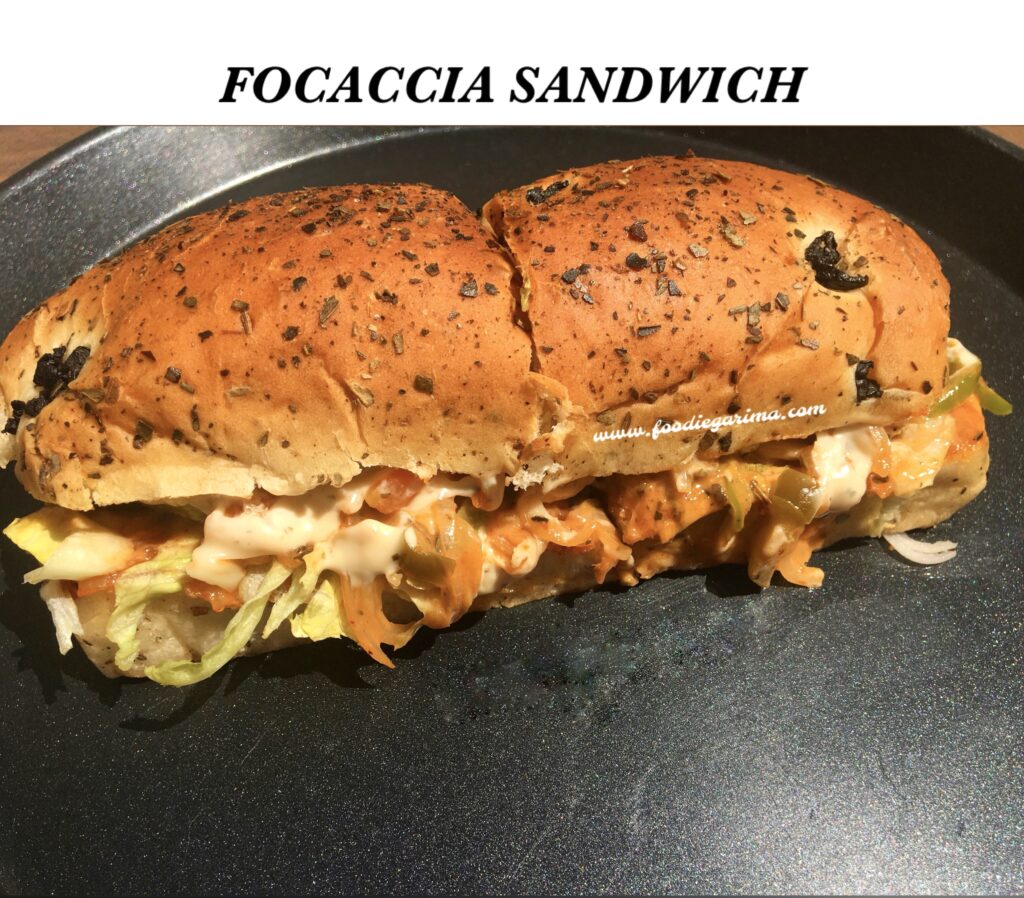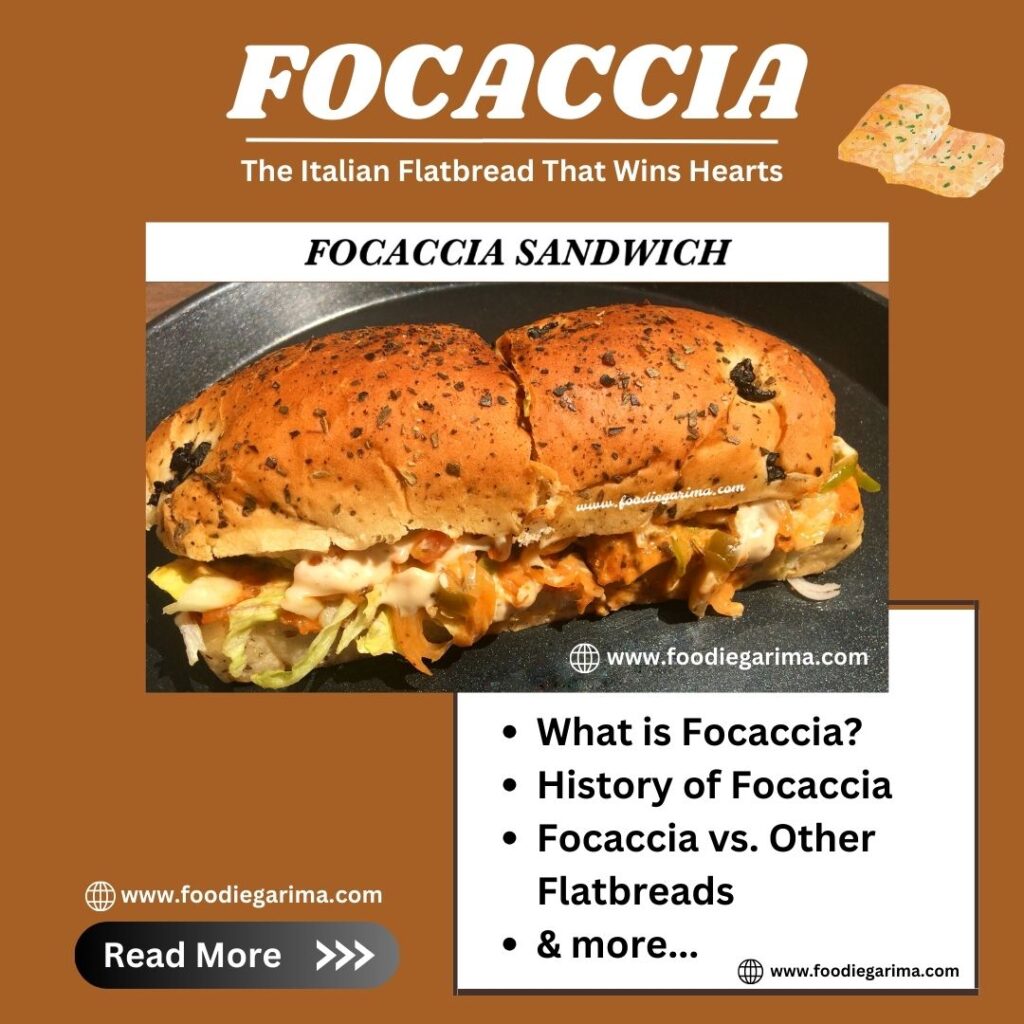11 January, 2025
Focaccia | All About This Beloved Italian Flatbread

Focaccia Flatbread
Focaccia: The Italian Flatbread That Wins Hearts
Focaccia has long been a beloved part of Italian cuisine, enjoyed as a snack, a side dish, or even a meal in itself. But what makes this soft, aromatic, and flavorful bread so special?
In this article, we will dive deep into everything you need to know about Focaccia, from its history and cultural significance to how it’s made and served.
Introduction to Focaccia
Focaccia is one of those comforting, versatile breads that everyone seems to love. It’s simple but full of flavor—perfect as a side, snack, or even the star of a meal. Whether you’re dipping it in olive oil, topping it with herbs, or using it for sandwiches, there’s no wrong way to enjoy Focaccia. But what exactly is it?
What is Focaccia?
Focaccia is an Italian “flatbread” that has a texture similar to Pizza dough but is thicker and fluffier. It’s traditionally made from Flour, Water, Yeast, Salt, and Olive Oil. The dough is left to rise and then baked to perfection, often seasoned with Rosemary, Sea Salt, or even Olives.

Focaccia’s Popularity Worldwide
Though it originates from Italy, Focaccia has spread across the globe and become a favorite in many countries. Whether you’re in a small café in Rome or at a bakery in New York, you’re likely to encounter this delicious, golden-brown treat.
The History of Focaccia
The history of Focaccia is as rich and warm as its flavor. This flatbread has been enjoyed for centuries, and its roots trace back to Ancient Rome.
Origins of Focaccia in Ancient Rome
Focaccia’s story begins as early as Roman times when it was referred to as “panis focacius,” meaning “hearth bread.” In those days, bread was often baked on the hearth, and the Roman version of Focaccia was quite simple, made from Flour, Water, and Olive Oil.
Evolution of Focaccia in Italy
As centuries passed, Focaccia recipes evolved and regional variations developed. In Italy, the bread became more elaborate, with toppings like Rosemary, Garlic, and Olives becoming common. Today, Focaccia is a staple in Italian cuisine, especially in regions like Liguria, where it’s known as Focaccia Genovese.
Focaccia vs. Other Flatbreads
At first glance, Focaccia may appear to be similar to other flatbreads like Pita or Naan, but there are distinct differences that set it apart.
How Focaccia Differs from Other Flatbreads
Unlike Pita, which puffs up when baked, Focaccia remains flat, with a soft, airy crumb. It’s also thicker than many other flatbreads, and its flavor is enhanced with Olive Oil, making it richer. Additionally, Focaccia is often seasoned with Herbs and Salt, adding to its distinctive taste.
How Focaccia Differs from Pizza Despite Having Similar Dough Base
While both Focaccia and Pizza share a similar dough base, Focaccia is a thicker, fluffier, and more bread-like creation, while Pizza has a thin, crispy crust with a wider range of toppings and a more pronounced focus on the sauce and cheese.
- Dough:
- Focaccia: The dough for Focaccia is typically thicker and fluffier, and it’s often made with more olive oil, which contributes to a richer texture. It’s meant to be soft and airy, with a slightly crisp crust.
- Pizza: Pizza dough is thinner and more elastic. It’s designed to be stretched out very thin, providing a crispier, lighter crust when baked at high temperatures.
- Texture:
- Focaccia: Focaccia has a pillowy, soft interior with a light crumb, and the crust is slightly chewy with a crisp finish.
- Pizza: Pizza has a crisp, crunchy crust, especially around the edges, with a chewy interior. The texture varies depending on the style, from thin crust to thick crust.
What Makes Focaccia Unique?
Focaccia is unique because it combines simplicity with versatility. It’s incredibly easy to make but can be customized with various toppings, from savory to sweet. Whether you want to top it with rosemary or sweeten it with honey, focaccia adapts to your taste preferences.
Ingredients You Need For Focaccia
- All-Purpose Flour
- active Dry Yeast
- warm Water
- Olive Oil
- Salt
- Sugar
- Coarse Sea Salt (for sprinkling)
- Fresh Rosemary (optional)
Tips for Perfect Focaccia
- Use high-quality Olive Oil for the best flavor.
- Let the dough rise properly to get a light, airy texture.
- Experiment with toppings like Olives, Garlic, or even sun-dried Tomatoes.
Variations of Focaccia
While the traditional Focaccia is delicious on its own, there are many ways to get creative with toppings and flavors.
Focaccia Genovese: A Regional Classic
One of the most famous variations is Focaccia Genovese, hailing from the region of Liguria. It’s made with a generous amount of olive oil, giving it a soft, airy texture with a slightly crispy crust.
Focaccia al Rosmarino (Rosemary Focaccia)
Focaccia al Rosmarino is the classic version that’s often topped with fresh rosemary and coarse salt. The fragrant rosemary pairs perfectly with the bread’s rich olive oil flavor.
Sweet Focaccia Varieties
Sweet focaccia, such as Focaccia Dolce, is also a treat. This version can be topped with sugar, honey, and fruits like grapes or figs, offering a delightful balance of sweetness and bread.
Serving Focaccia
Focaccia is incredibly versatile when it comes to serving. Here’s how to enjoy it:
How to Serve Focaccia at Home
Serve Focaccia warm, straight from the oven, or at room temperature. Slice it into squares or wedges for easy sharing.
Focaccia as a Side Dish
Pair Focaccia with Soups, Stews, or Salads. It makes the perfect accompaniment to any meal.
Using Focaccia as a Base for Sandwiches
Cut Focaccia into sandwich-sized pieces and stuff them with your favorite fillings, like roasted vegetables, and cheese. It’s an excellent choice for a delicious and hearty lunch.
Health Benefits of Focaccia
Though it’s often seen as a treat, Focaccia can be part of a healthy diet if consumed in moderation.
Is Focaccia Healthy?
Focaccia can be a good source of carbohydrates, which provide energy. However, due to the olive oil, it also contains healthy fats that can contribute to heart health.
Healthier Focaccia Variations
You can make focaccia healthier by using whole wheat flour or adding extra seeds and herbs for added fiber and nutrients.
Focaccia in Italian Culture
In Italy, focaccia holds a special place in the culinary tradition. It’s not just a type of bread—it’s a symbol of Italian hospitality and family gatherings.
The Role of Focaccia in Italian Cuisine
Focaccia is often made during holidays or family get-togethers. It’s a dish that’s meant to be shared, enjoyed, and savored in the company of others.
Focaccia During Holidays and Special Occasions
In regions like Liguria, Focaccia is a must-have during festive occasions like Christmas, where it’s served alongside other regional specialties.
How to Store Focaccia
To make sure your focaccia stays fresh, proper storage is key.
Storing Fresh Focaccia
Keep focaccia in an airtight container at room temperature for up to 2-3 days. To refresh it, simply heat it in the oven for a few minutes before serving.
Troubleshooting Common Focaccia Problems
Even the most experienced bakers can run into problems with focaccia. Here are some common issues and how to fix them.
Why is My Focaccia Too Dense?
If your Focaccia turns out too dense, it might not have risen enough. Make sure you’re using fresh Yeast and giving the dough enough time to rise.
How to Avoid a Soggy Focaccia
To avoid sogginess, be sure to drain any excess liquid from toppings like tomatoes or olives before adding them to the dough.
How to Get a Crispy Crust
For a crispy crust, bake your Focaccia on a high heat and use a well-oiled pan.
Focaccia’s Growing Popularity Outside Italy
As the world becomes more interested in Italian cuisine, Focaccia is becoming a staple in many countries beyond Italy. Its simple ingredients and versatility make it an easy favorite for home cooks and chefs alike.
Focaccia is more than just a bread—it’s a piece of Italian history and culture, rich in flavor and tradition. Whether you enjoy it plain or with your favorite toppings, it’s a dish that brings people together and celebrates the joy of good food.
FAQs
What is the best flour to use for Focaccia?
The best flour for Focaccia is all-purpose flour or bread flour, as they provide the ideal texture and structure.
Can I make Focaccia without yeast?
While yeast is traditional for focaccia, you can experiment with baking soda or baking powder for a quicker, no-yeast version.
How long can I store Focaccia?
Focaccia can be stored for up to 2-3 days at room temperature in an airtight container.
Is it okay to add toppings to Focaccia before baking?
Yes! Toppings like rosemary, olives, and garlic are traditionally added before baking to infuse the bread with flavor.
Can I make gluten-free Focaccia?
Yes, you can make gluten-free focaccia by using a gluten-free flour blend and ensuring all other ingredients are suitable for a gluten-free diet.
